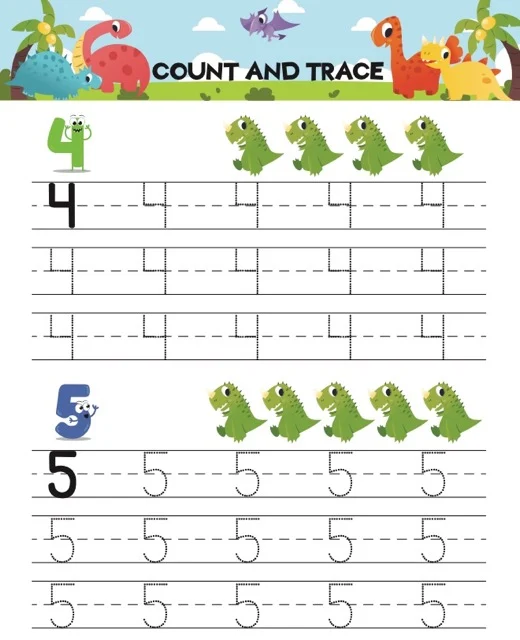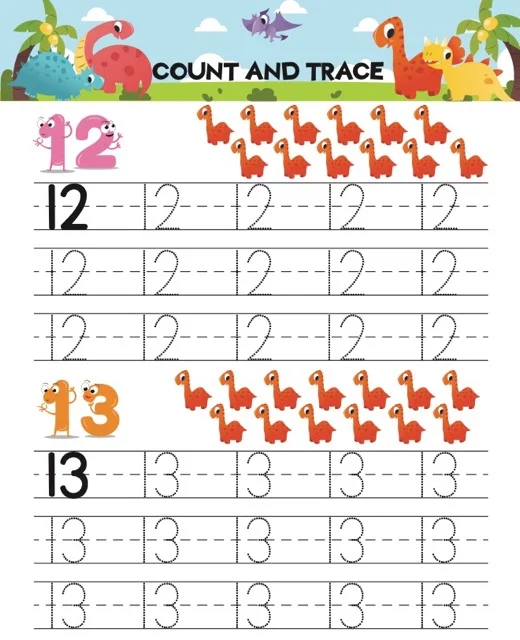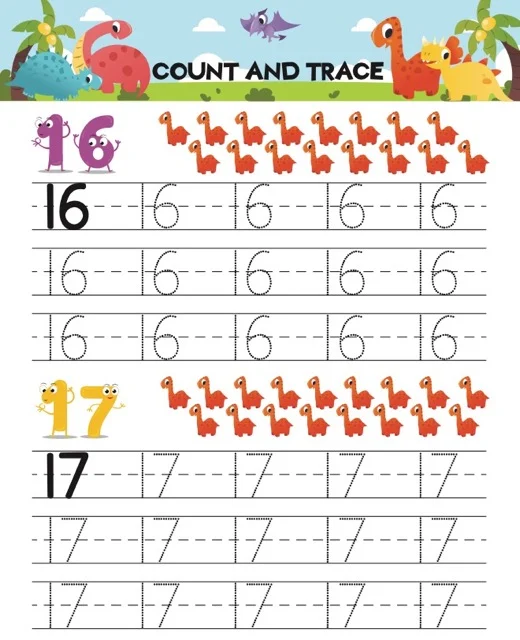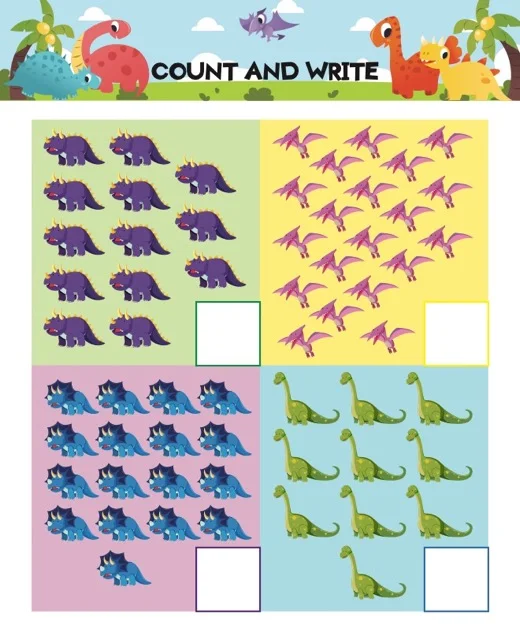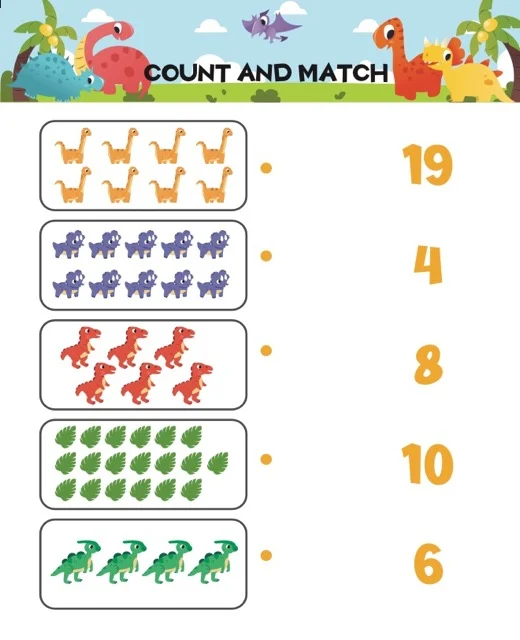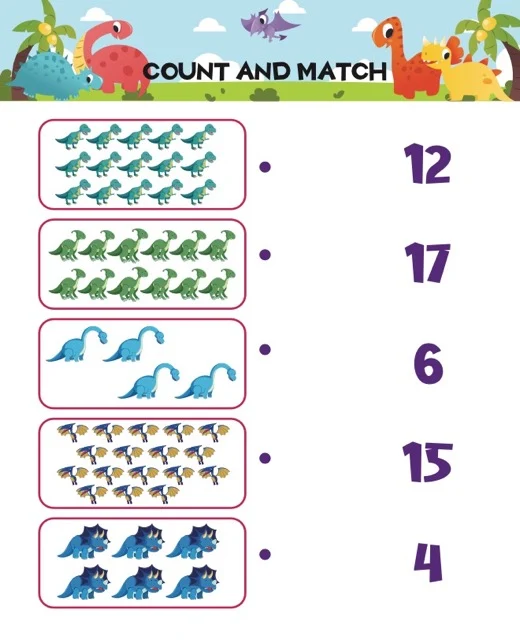Dinosaur Math for Preschoolers
Three sources detail dinosaur-themed math activities for preschool and early elementary students. These activities focus on building fundamental math skills like counting and addition, progressing in complexity. The activities are adaptable to various settings and other themes, requiring readily available materials. One source visually demonstrates activities such as tracing, counting, and puzzle-based addition. Overall, the resources advocate for engaging young learners through playful, adaptable math exercises.
Dinosaur Math Activities for Early Learners
Briefing Doc: Dinosaur Math Activities for Early Learners
Overview:
This briefing doc analyzes three sources: "Dinosaur Math Activities for Preschool and Early Elementary," "Dinosaur Math: A Study Guide," and "Testing Theme: Dinosaur Math Activities.pdf". These sources provide a comprehensive overview of dinosaur-themed math activities designed for preschool and early elementary students.
Key Themes:
●
Engaging Math Learning: The core theme across all sources is leveraging the popularity of dinosaurs to create fun and engaging math activities for young children.
●
Skill Development: These activities aim to develop fundamental math skills such as counting, number recognition, basic addition and subtraction, color and shape recognition, and fine motor skills.
●
Versatile Applications: The activities are suitable for various settings, including individual practice, group work, learning centers, and home learning environments.
Important Ideas/Facts:
●
Target Age Group: The primary audience for these activities is preschool and early elementary students. ("Dinosaur Math Activities FAQ" and "Dinosaur Math: A Study Guide")
●
Progressive Difficulty: Activities are structured to progress in difficulty, starting with basic counting and moving towards addition, subtraction, and more complex activities like number puzzles. ("Dinosaur Math Activities FAQ" and "Dinosaur Math: A Study Guide")
●
Adaptability: While dinosaur-themed, the core concepts can be easily adapted to other themes based on children's interests. ("Dinosaur Math Activities FAQ" and "Dinosaur Math: A Study Guide")
●
Material Requirements: Most activities require readily available materials like printable worksheets, pencils/crayons, and optional counters. ("Dinosaur Math Activities FAQ" and "Dinosaur Math: A Study Guide")
●
Tracing and Counting: "Testing Theme: Dinosaur Math Activities.pdf" visually emphasizes tracing and counting dinosaurs to match a number as a prominent activity. ("Dinosaur Math: A Study Guide")
●
Addition Through Puzzles: The "Testing Theme" source introduces basic addition through dinosaur-themed puzzles. ("Dinosaur Math: A Study Guide")
Quotes:
●
"The activities are primarily geared towards preschool and early elementary students, focusing on fundamental math concepts." ("Dinosaur Math Activities FAQ")
●
"The activities seem to progress from basic counting and number recognition to simple addition and subtraction, eventually leading to more complex activities like number puzzles." ("Dinosaur Math: A Study Guide")
●
"Yes, the core math concepts can be easily adapted to other themes. Simply replace the dinosaur images with images of objects or characters that interest the child." ("Dinosaur Math: A Study Guide")
Conclusions:
Dinosaur-themed math activities offer a playful and engaging way to introduce and reinforce foundational math concepts for young learners. Their versatility, adaptability, and focus on progressive learning make them valuable tools for educators and parents alike. The provided PDF visually showcases a range of activities, including tracing, counting, matching, and basic addition through puzzles, confirming the information presented in the text sources.
Dinosaur Math Activities for Preschool and Early Elementary
Dinosaur Math Activities FAQ
1. What age group are these dinosaur math activities designed for?
These activities are primarily geared towards preschool and early elementary students, focusing on fundamental math concepts.
2. What specific math skills do these activities help develop?
The activities cover a range of skills including:
●
Counting and Number Recognition: Activities like "Count and Match" and tracing help children learn number sequences and recognize numerals.
●
Basic Addition and Subtraction: Simple addition and subtraction problems within the range of 1-20 are introduced through fun dinosaur themes.
●
Color and Shape Recognition: Some activities involve matching colors and shapes, reinforcing these basic visual skills.
●
Fine Motor Skills: Activities like tracing and coloring help develop hand-eye coordination and fine motor control.
3. Are the activities presented in a specific learning order?
While there's no strict order, the activities seem to progress in difficulty. Starting with counting and number recognition, they gradually introduce addition and subtraction, eventually leading to more complex activities like number puzzles.
4. How can these activities be used in a classroom setting?
These activities can be incorporated in various ways:
●
Individual Practice: Worksheets can be used for individual practice during math lessons or as homework assignments.
●
Group Activities: Some activities can be adapted for group work, fostering collaboration and peer learning.
●
Learning Centers: Create a dedicated dinosaur math center where children can freely explore these activities.
5. Are these activities suitable for children who are not interested in dinosaurs?
While the dinosaur theme adds an element of fun and engagement, the core math concepts can be easily adapted to other themes. Simply replace the dinosaur images with images of other objects or characters that interest the child.
6. Can parents use these activities at home?
Absolutely! These activities are perfect for engaging children in learning at home. They can be used for supplementing classroom learning or for introducing math concepts in a playful way.
7. What materials are needed for these activities?
Most activities require basic materials like:
●
Printable worksheets
●
Pencils or crayons
●
Counters (optional)
8. Where can I find more dinosaur-themed math resources?
Several websites and educational publishers offer a wide range of dinosaur-themed math resources, including printable worksheets, games, and interactive activities. A simple online search for "dinosaur math activities" will yield many options.
Dinosaur Math: A Study Guide
Dinosaur Math: A Study Guide
Short-Answer Quiz
Instructions: Answer each question in 2-3 sentences.
1.
What age range are the dinosaur math activities primarily designed for?
2.
Identify three specific math skills that these activities help develop.
3.
Describe how the activities progress in terms of difficulty.
4.
Suggest two ways these activities can be used in a classroom setting.
5.
Can the activities be adapted for children who aren't interested in dinosaurs? Explain.
6.
Are these activities suitable for use at home? Why or why not?
7.
List three basic materials needed for most of the activities.
8.
Where can you find additional dinosaur-themed math resources?
9.
Based on the "Testing Theme" source, what type of counting activity is prominent?
10.
Looking at the "Testing Theme" source, what basic math operation is introduced through dinosaur-themed puzzles?
Answer Key
1.
The activities are primarily designed for preschool and early elementary students.
2.
The activities help develop counting and number recognition, basic addition and subtraction, and color and shape recognition. They also promote fine motor skill development.
3.
The activities seem to progress from basic counting and number recognition to simple addition and subtraction, eventually leading to more complex activities like number puzzles.
4.
The activities can be used for individual practice during math lessons or as homework assignments. They can also be adapted for group work, fostering collaboration and peer learning. A dedicated dinosaur math center could also be created for free exploration.
5.
Yes, the core math concepts can be easily adapted to other themes. Simply replace the dinosaur images with images of objects or characters that interest the child.
6.
Absolutely, the activities are perfect for engaging children in learning at home. They can supplement classroom learning or introduce math concepts playfully.
7.
Basic materials include printable worksheets, pencils or crayons, and optional counters.
8.
Many websites and educational publishers offer dinosaur-themed math resources. A simple online search for "dinosaur math activities" will yield many options.
9.
The prominent counting activity is tracing and counting dinosaurs to match a given number.
10.
Basic addition is introduced through dinosaur-themed puzzles.
Essay Questions
1.
Discuss the benefits of using a thematic approach, such as dinosaurs, in early math education. How can this approach enhance engagement and learning?
2.
Explain how dinosaur math activities can be differentiated to cater to different learning styles and abilities within a classroom setting. Provide specific examples.
3.
Analyze the role of play-based learning in developing early math skills. How can dinosaur math activities be designed to encourage playful exploration of mathematical concepts?
4.
Evaluate the effectiveness of using printable worksheets as a primary tool for teaching math concepts to young children. What are the advantages and limitations of this approach?
5.
Compare and contrast the use of dinosaur math activities in a formal classroom setting versus a home learning environment. How can the activities be adapted for each context?
Glossary of Key Terms
●
Number Recognition: The ability to identify and name numerals.
●
Counting: The process of determining the total number of items in a set.
●
Addition: The mathematical operation of combining two or more numbers to get a total.
●
Subtraction: The mathematical operation of finding the difference between two numbers.
●
Fine Motor Skills: Small, precise movements involving the hands and fingers.
●
Differentiation: Adapting instruction to meet the individual needs of learners.
●
Play-Based Learning: An approach to learning that emphasizes exploration, discovery, and active engagement through play.
●
Formal Classroom Setting: A structured learning environment led by a teacher.
●
Home Learning Environment: A less structured learning environment that takes place in the home, often guided by parents or caregivers.
●
Thematic Approach: Using a specific theme or topic to organize learning activities.


